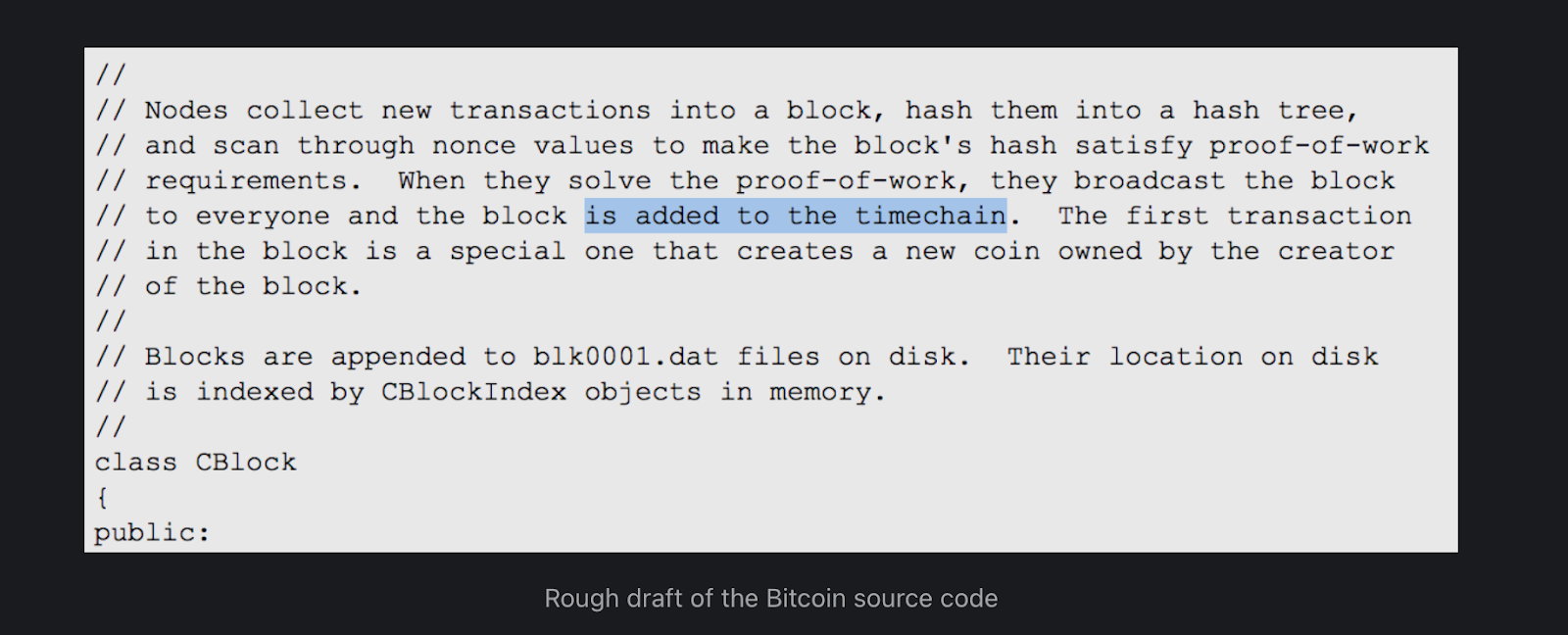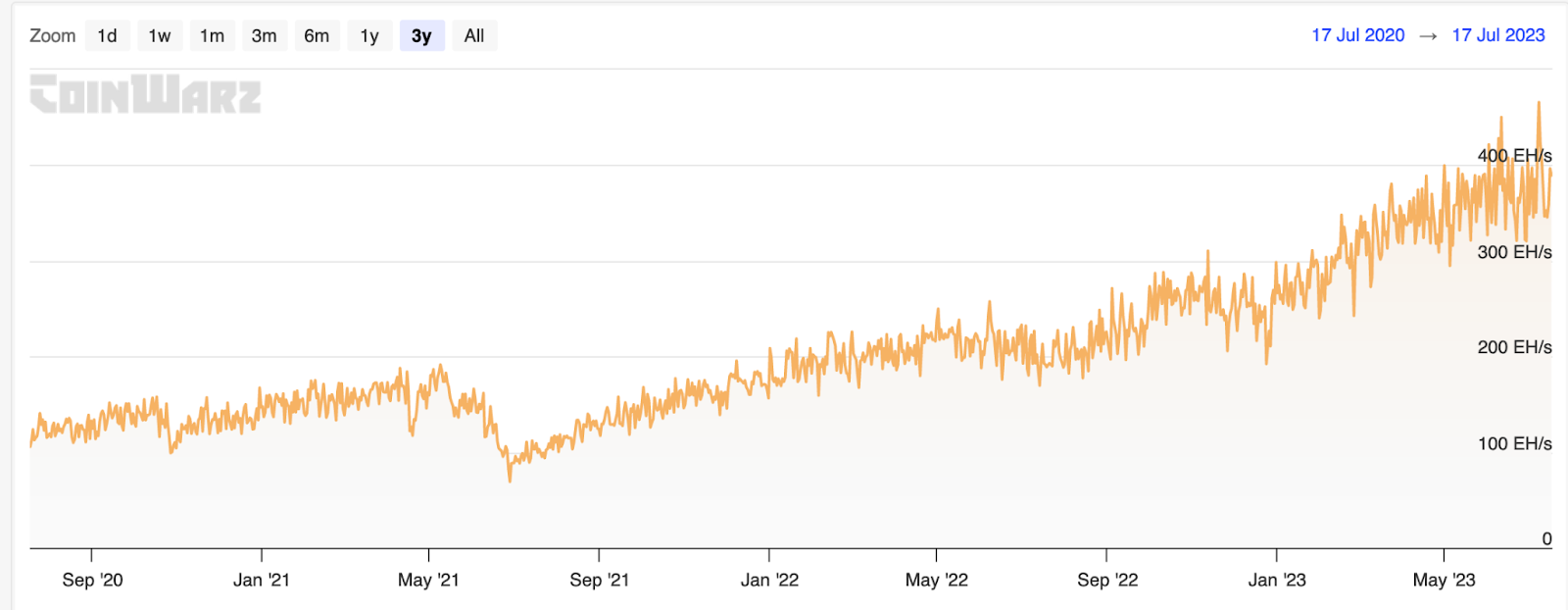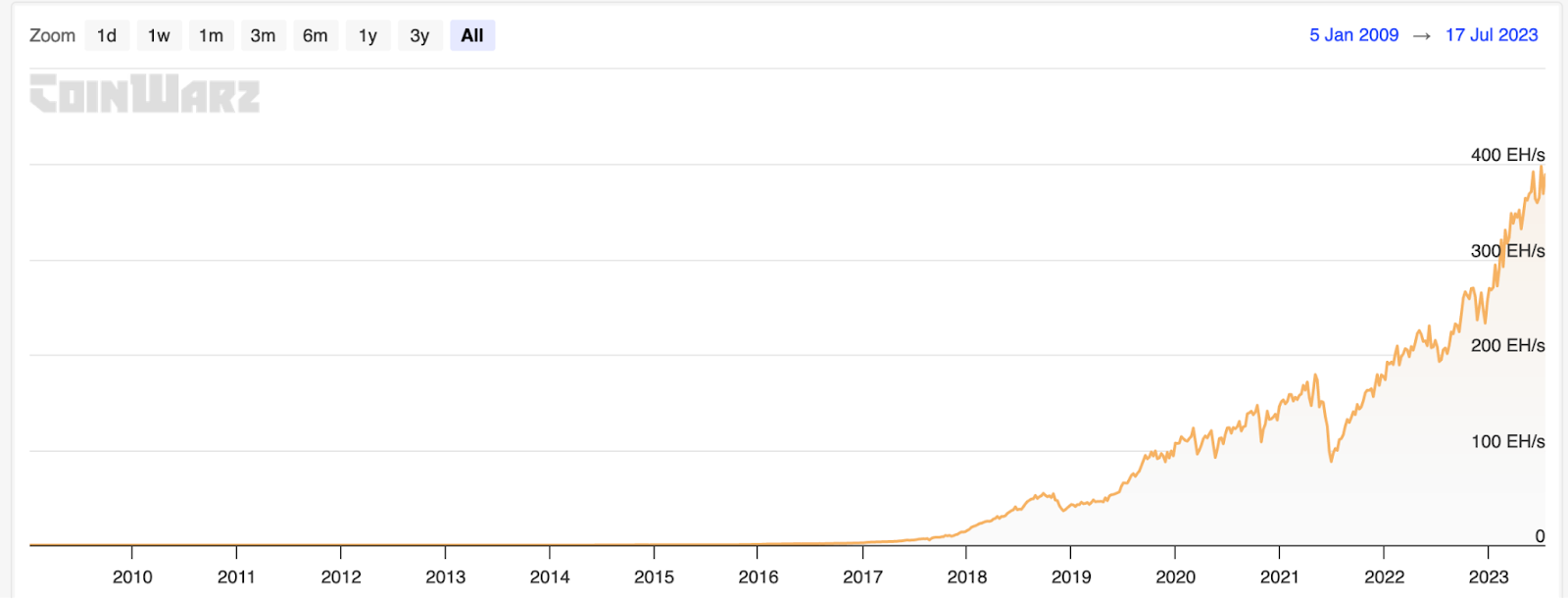Hash Rates Are the Number of Guesses Per Second Competing to Add a Block to the Timechain
Article by Frank America | Edited by Trewkat and Hiro Kennelly | Cover Art by Chameleon
As of today, July 17, 2023, Bitcoin’s hash rate is 367.06 EH/s or 361,920,000 TH/s. The highest the Bitcoin hash rate has ever reached is 538.05 EH/s, or 538,050,000 TH/s. But what does that even mean and why does it matter? Before we break down these cryptic numbers, let’s discuss the basics.
The Basics of Hashing
The Bitcoin blockchain uses proof-of-work (PoW) to achieve consensus. What this means is that computing power is expended in order to be first to successfully guess the answer to a complex math problem called a hash function, the purpose of which is to cryptographically link blocks together. The people applying their computing power to try to solve this math problem first and therefore earn bitcoin for securing the network are known as ‘miners’, and that’s where we get the terms, bitcoin miners and bitcoin mining.
A simple way to think of hash rates is that more people mining bitcoin increases the hash rate. More guesses: hash goes up; fewer guesses: hash goes down. Also, the Bitcoin protocol adjusts the hash difficulty according to this variation in demand, which will be covered a little further down.
First, let’s take an easy real-world example, when China banned bitcoin mining back in May of 2021. This resulted in a lot of miners going offline, closing up shop to head for friendlier jurisdictions. The drop in miners immediately lowered the number of guesses per second occurring (hash rate) by more than 50%, which after the difficulty adjustment that followed, made solving the hash much easier for a smaller pool of bitcoin miners.
The Ten-Minute Median
When the complexity of the hash is too hard it takes bitcoin miners more than ten minutes to solve it. When the complexity of the hash is too easy it takes bitcoin miners less than ten minutes to solve it. Why ten minutes? The protocol was designed to self-correct its complexity to try and target one hash being solved approximately every ten minutes. This is a mathematical adjustment to preserve a continuous block time. If it’s at the protocol level, it’s in the code, so how does that code execute itself?
The Bitcoin Timechain
Every 2,016 blocks, or approximately every two weeks, the Bitcoin blockchain adjusts the difficulty of its hash to try and hit that optimal block time. When the complexity of the hash is just right, the Bitcoin blockchain produces a new block every ten minutes. In this article by Marty Bent, published in 2019, he found original notation written by Satoshi Nakamoto, actually referring to the Bitcoin blockchain as a “timechain�?. A more recent Bitcoin Magazine article has encouraged this name as it is more logical, clear, and straightforward to a newly arriving bitcoiner.
Bitcoin, as such, is a perpetually self-correcting timechain.

Hashing Drop in China
Between May 9 and June 28, 2021, the hash rate (number of attempts at the puzzle per second) dropped from 191 EH/s, down to 69 EH/s, hence the over 50% drop in hashing power. As mentioned, a bunch of people had packed up shop, and this took a lot of bitcoin miners out of the guessing game. Incidentally, as reported by the BBC, many of them ended up in Texas.
Two weeks after this 50% decline in hashing power, Bitcoin lowered the complexity of its “hash puzzle�? by 28%, making it easier for the remaining miners to realign with the optimal block time established by the protocol. Take a look at the 3-year spread on this hash chart, and then the all-time one beneath it, to see how this event affected a drop hash rate.


The above happened in China in May of 2021, which resulted in an influx of new miners coming online in the U.S., enticed by an open jurisdiction and by the greater probability of solving the hash and procuring the bitcoin rewards. By December 25, 2021, the hash rate of Bitcoin was back up to 182 EH/s.
Unpacking the Cryptic Nature of Hash Rates
According to SoFi.com, “Bitcoin’s hash rate refers to the amount of computing and process power being contributed to the network through mining.�? To break that down a bit further: Investopedia defines hash rate as, “measured by the number of hashes (or guesses) per second on a blockchain network.�? So if there are thousands of guesses per second, that would mean the hash rate would be measured in kilo-hashes KH/s. If there were millions of hashes per second the PoW blockchain would be measured in mega-hashes MH/s. Billions are in giga-hashes, or GH/s. A trillion guesses per second is measured in tera-hashes TH/s. Quadrillion is in peta-hashes per second, or PH/s. And quintillion is measured in exa-hashes per second, or EH/s.
So back to the cryptic number above, as of this writing, every second there are 367 exa-hashes per second, or 367,920,000 quintillion guesses per second trying to solve the hash puzzle on the Bitcoin blockchain. One quintillion is one-thousand quadrillions, or a 1 with 18 zeros after it. Another way to express this is 10¹�?� power, or a million million millions. Scientists estimate there are 10 quintillion insects on earth; as of today, there are 36 million times more guesses per second occurring to solve the hash and add a block to the Bitcoin timechain than there are insects in the world.
The Economic Impact of Annual Bitcoin Mining Energy Costs
Making this many guesses this frequently consumes a lot of energy. Cambridge’s Bitcoin Electricity Consumption Index pegs current bitcoin miner usage at ~140 terawatts per hour (TW/h) annually. In USD, the average price of electricity globally is 5 cents per kilowatt-hour. A terawatt is a billion kilowatts. At 5 cents per kilowatt an hour, 140 terawatts per hour (TW/h) annually costs 613.2 billion dollars.

{[(140 TW/h * 24 hours) * 365 days] / .05 cents } / 100 cents = $613.2 Billion dollars
Currently, the market cap of bitcoin is $580 billion. This near parity is not an accident. The market cap of bitcoin is causally related to the cost of mining bitcoin. Higher-value bitcoin, more guessers hunting for the hash, equals greater costs. Lesser-value bitcoin, the opposite.
The lagging complexity of Bitcoin’s hash rate is therefore causally related to the value of a single bitcoin. The same is true of mining gold. This research paper indicates the price valuation of gold similarly influences the cost of gold production.
Market Value/Mining Cost Parity
Interestingly, I arrived at the average electrical costs of the PoW system by extrapolating the cost of tera-hashes per hour into a yearly total, vis-a-vis the estimated cost of 5 cents per kilowatt-hour. It was curious to discover that number was so close to the market cap of bitcoin on coinmarketcap.com. Perhaps the additional discrepancy of $33 billion can be explained by non-electrical costs such as changing price of ASICs, and real-world necessity of renting warehouse space. Regardless, if price goes up, we will probably continue to see hash rates rise, as more bitcoin miners come online to get that sweet, sweet, block reward.
Author Bio
Frank America is Editor-in-Chief of The Rug News, and a Content Manager/Staff Writer at Bankless Publishing.
Editor Bios
trewkat is a writer, editor, and designer at BanklessDAO. She’s interested in learning about crypto and NFTs, with a particular focus on how best to communicate this knowledge to others.
Hiro Kennelly is a writer, editor, and coordinator at BanklessDAO, an Associate at Bankless Consulting, and is still a DAOpunk.
Designer Bio
Chameleon is a designer and creator in the web3 space.
BanklessDAO is an education and media engine dedicated to helping individuals achieve financial independence.
This post does not contain financial advice, only educational information. By reading this article, you agree and affirm the above, as well as that you are not being solicited to make a financial decision, and that you in no way are receiving any fiduciary projection, promise, or tacit inference of your ability to achieve financial gains.
Bankless Publishing is always accepting submissions for publication. We’d love to read your work, so please submit your article here!
More Like This
The Crazy World of Bitcoin by Tigi76
BlackRock Bitcoin ETF a Generational Endorsement by Frank America
The Byzantine Generals Problem, 51% Attacks, and Proof of Work by Jake and Stake






